Building a Competency-Based Teacher Education Program: The High Meadows Experience, Part 2
CompetencyWorks Blog
In my first blog post, I introduced the principles and structure of High Meadows Graduate School of Teaching and Learning, a competency-based teacher education program that operated from 2018 to 2022. (In June, 2022, High Meadows transferred its programs to the University of Kansas to offer them at scale.) In this post, I describe three significant issues we faced in building and operating an innovative model of pre-service teacher preparation.
Assessing Dispositional Competencies through Portfolios
As I noted in my earlier post, the curriculum at High Meadows took the form of what we called “challenges,” or complex problems of teaching practice. Candidates did not demonstrate only a single competency in each challenge. Rather, they learned and demonstrated learning objectives from multiple competencies, consistent with our belief that teaching demands performing many different skills simultaneously. Moreover, we did not treat all competencies equally. While teacher candidates were required to demonstrate all of the learning objectives in every competency at least once, we required that they demonstrate some objectives multiple times, in the context of different challenges and at increasing levels of complexity and sophistication.
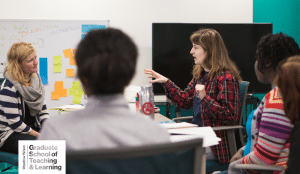 While challenges proved a productive way to help teacher candidates hone their skills, we soon learned that three High Meadows competencies – Thinking Like a Designer, Learning to Improve, and Collaborating for Change – were not well suited to evaluation in this way. For one thing, the learning objectives for these competencies focused primarily on process rather than product. Requiring evidence for them in a challenge with another pedagogical goal proved to be overly burdensome for teacher candidates. In addition, we included these competencies to cultivate not just skills, but also dispositions, in High Meadows graduates. That is, we hoped to see enough examples of a teacher candidate exhibiting these competencies that we could confidently claim that they had fully incorporated them into their teaching practice.
While challenges proved a productive way to help teacher candidates hone their skills, we soon learned that three High Meadows competencies – Thinking Like a Designer, Learning to Improve, and Collaborating for Change – were not well suited to evaluation in this way. For one thing, the learning objectives for these competencies focused primarily on process rather than product. Requiring evidence for them in a challenge with another pedagogical goal proved to be overly burdensome for teacher candidates. In addition, we included these competencies to cultivate not just skills, but also dispositions, in High Meadows graduates. That is, we hoped to see enough examples of a teacher candidate exhibiting these competencies that we could confidently claim that they had fully incorporated them into their teaching practice.
Therefore, to evaluate these three “process” competencies, we added another form of assessment: the portfolio. For each of three annual portfolio reviews, teacher candidates curated artifacts of their own choosing to demonstrate mastery, from their work on challenges as well as from their clinical placement. They typically targeted a focused number of learning objectives in each of a series of review sessions. For example, the Thinking Like a Designer competency had six learning objectives and required candidates to demonstrate all aspects of the design process, from gathering information about users’ needs to getting feedback on prototypes. Candidates usually presented evidence for the early elements of the process in the first review and for later elements in subsequent ones.
The portfolio reviews were carefully planned. Candidates submitted their materials a week ahead of time to two members of the staff, who were assigned as their evaluators. Each review lasted about an hour, with the candidate taking the first 20 minutes to explicate the artifacts presented and the evaluators taking the next 30 minutes to ask questions. At the end of each review, candidates received a portfolio report that provided both qualitative feedback and an indication of whether or not they had demonstrated sufficient mastery for all learning objectives in each competency.
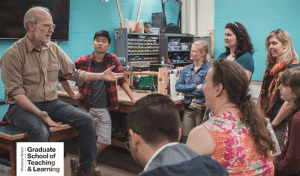 Portfolios proved to be a valuable addition to the High Meadows program. Not only did they permit a holistic assessment of a teacher candidate’s dispositions, they also invited rich discussion between staff and teacher candidates about challenging issues of teacher practice. Additionally, the portfolios provided staff a snapshot into each candidate’s development as they progressed through the program, especially in those domains of teaching that are often the most difficult to evaluate.
Portfolios proved to be a valuable addition to the High Meadows program. Not only did they permit a holistic assessment of a teacher candidate’s dispositions, they also invited rich discussion between staff and teacher candidates about challenging issues of teacher practice. Additionally, the portfolios provided staff a snapshot into each candidate’s development as they progressed through the program, especially in those domains of teaching that are often the most difficult to evaluate.
Fostering Collaboration while Allowing for Variability in Time to Degree Completion
Convinced that collaboration among educators is critical to improving schools, we sought to prepare teachers with the skills and inclination to work in concert with others. Indeed, we specifically identified collaboration as one of our critical competencies and required that teacher candidates demonstrate evidence of it in multiple ways. We believed that teachers should collaborate with many different groups – with parents, community members, and students themselves – but that they especially need to develop their capacity to work effectively with colleagues.
At the same time, we were committed to personalizing each student’s path through the program, including their engagement with each challenge. Thus, we struggled with a puzzle: how could we ensure that teacher candidates practice collaboration without requiring they proceed lock step at the same pace through the curriculum?
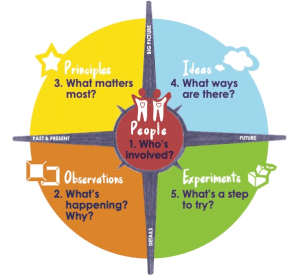
Our primary solution was to create a weekly schedule that offered deliberate opportunities for both individualized instruction and collaboration. Students met twice a week at High Meadows (first in-person, and then virtually). In one of these sessions, staff members led teacher candidates through learning experiences for challenges based on a pre-announced calendar. These meetings typically introduced major themes and concepts associated with the challenge and provided the context for personalized, deeper learning. In the second session, teacher candidates met with their peers to debrief their clinical experiences during the previous week. Using a design thinking protocol called the Innovator’s Compass, created by Ela Ben Ur, candidates worked together to ideate and prototype solutions to issues that they identified from their teaching. The sessions also provided opportunities for candidates to organize work sessions with peers, from trying out a lesson plan to collaborating on a challenge solution.
This format promoted the collaboration we sought to develop while also offering candidates variability in pacing for completing degree requirements. Most teacher candidates engaged with challenges at the same time but submitted challenge solutions at their own pace. And even those at quite different stages in their progress through the program, or from different age levels or disciplines, learned to collaborate effectively to address shared concerns from their clinical placements.
Shifting from In-person to Remote Instruction
Like many institutions, High Meadows shifted its program abruptly from in-person to remote learning in March 2020. Practicum and Studio sessions took place over Zoom rather than at the Graduate School offices, and teacher candidates met in virtual breakout sessions rather than actual conference rooms. The transition was further complicated by the fact that all of the candidates’ clinical placements went remote as well. This meant that the staff at High Meadows needed to revisit all of the learning objectives for each competency. We wanted to ensure that our program requirements were sufficient to prepare teacher candidates to support their students’ learning, but not impossible to achieve in the context of the pandemic. In short, it made us prioritize what mattered most, and then we redesigned the teaching and learning experiences to support candidates’ development.
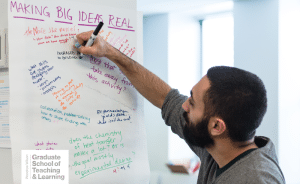 After a thoroughgoing review, we made two significant changes to the curriculum. The first was to recognize those competencies that teacher candidates were already satisfying through remote instruction. For example, while one of the challenges asked teacher candidates to investigate and experiment with educational technology, we determined that the everyday use of remote tools satisfied the learning objectives for that challenge and required no additional evidence from candidates to demonstrate competency. The second change was to adjust the solution requirements to accommodate the circumstances in which teacher candidates found themselves. In some cases where we had previously required that they implement and iterate on a strategy as part of a solution, for instance, we modified the requirement in light of Covid-19 to require only that they submit a design for the strategy.
After a thoroughgoing review, we made two significant changes to the curriculum. The first was to recognize those competencies that teacher candidates were already satisfying through remote instruction. For example, while one of the challenges asked teacher candidates to investigate and experiment with educational technology, we determined that the everyday use of remote tools satisfied the learning objectives for that challenge and required no additional evidence from candidates to demonstrate competency. The second change was to adjust the solution requirements to accommodate the circumstances in which teacher candidates found themselves. In some cases where we had previously required that they implement and iterate on a strategy as part of a solution, for instance, we modified the requirement in light of Covid-19 to require only that they submit a design for the strategy.
High Meadows always tried to “model the model” of what teaching and learning should be. So we seized on the set of constraints and opportunities offered during remote instruction to consider a number of important questions, such as:
- What is the right balance between synchronous and asynchronous learning (especially if working in collaboration is valued)?
- How do we foster teacher candidate engagement so that they are learning and supporting each other’s learning versus being dependent on faculty coaches?
- How can we learn from the on-the-ground experience of teacher candidates to help us define and explicate “what good looks like” in this new mode of teaching and learning?
While we came to no conclusive answers, our deliberations guided our experiments as we sought to support teacher candidates who were preparing for their careers in unprecedented times. We learned that they were much more capable of asynchronous learning than we had anticipated, especially when they had the chance to hone their new skills with students. At the same time, we recognized that teacher candidates still craved opportunities to debrief with peers about their triumphs and challenges in the classroom and to share strategies for common problems. Finally, we realized that teacher candidates, familiar as they were with the contexts of their classrooms and their schools, often had the best ideas for how to work effectively with their students in the novel circumstances of the pandemic.
Learning Differently to Teach Differently
Though most High Meadows graduates are currently teaching in conventional schools, many have introduced principles and experiences that are hallmarks of CBE into their classrooms. These include multiple ways and opportunities to demonstrate mastery, problem- and project-based learning, and assessments that allow students to progress through the curriculum at their own pace. As their careers progress, we anticipate that our alums will commit themselves even more strongly to competency-based learning. At High Meadows, we were convinced that in order to teach differently, teachers needed to learn differently. Having “modeled the model” of the ways we hoped our graduates would work with their future students, we are confident that our graduates are poised to teach and to lead the way in competency-based learning in the years to come.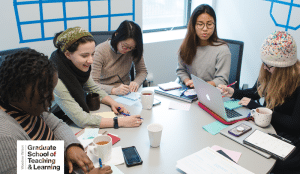
Learn More
- CBE Starter Pack 4: Progress Based on Mastery
- Building 21’s Studio Model: Designing Learning Experiences for Engagement and Impact
- Let Educators Drive: Gradual Release to Learner-Centered Design
- In Real Life: How Can CBE Systems Ensure Learning Is Deep, Ongoing, and Integrated?
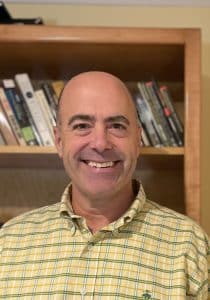 Dr. Peter Laipson is the founding Chief Academic Officer of High Meadows Graduate School of Teaching and Learning, a competency-based teacher education program. Formerly the Provost of Bard College at Simon’s Rock, he also taught and held leadership positions at Concord Academy.
Dr. Peter Laipson is the founding Chief Academic Officer of High Meadows Graduate School of Teaching and Learning, a competency-based teacher education program. Formerly the Provost of Bard College at Simon’s Rock, he also taught and held leadership positions at Concord Academy.